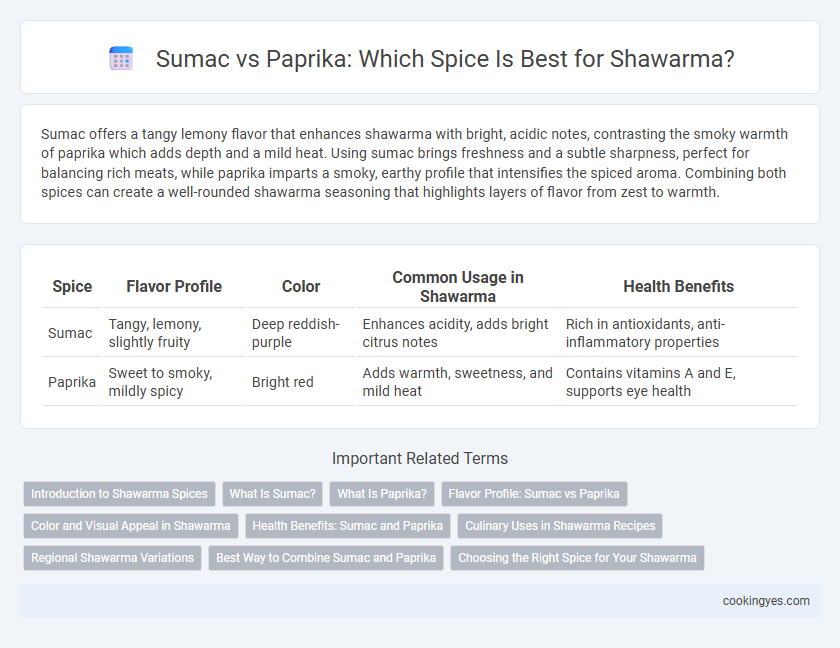Sumac offers a tangy lemony flavor that enhances shawarma with bright, acidic notes, contrasting the smoky warmth of paprika which adds depth and a mild heat. Using sumac brings freshness and a subtle sharpness, perfect for balancing rich meats, while paprika imparts a smoky, earthy profile that intensifies the spiced aroma. Combining both spices can create a well-rounded shawarma seasoning that highlights layers of flavor from zest to warmth.
Table of Comparison
| Spice | Flavor Profile | Color | Common Usage in Shawarma | Health Benefits |
|---|---|---|---|---|
| Sumac | Tangy, lemony, slightly fruity | Deep reddish-purple | Enhances acidity, adds bright citrus notes | Rich in antioxidants, anti-inflammatory properties |
| Paprika | Sweet to smoky, mildly spicy | Bright red | Adds warmth, sweetness, and mild heat | Contains vitamins A and E, supports eye health |
Introduction to Shawarma Spices
Sumac and paprika are essential spices that define the flavor profile of authentic shawarma, each bringing unique characteristics to the dish. Sumac offers a tangy, lemony zest that enhances the meat's savory depth, while paprika contributes a mild sweetness and vibrant red color, intensifying the visual appeal and smoky undertone. Combining sumac's acidity with paprika's warmth creates the complex, balanced taste signature to traditional Middle Eastern shawarma spices.
What Is Sumac?
Sumac is a tangy, lemony spice derived from the dried and ground berries of the sumac plant, commonly used in Middle Eastern cuisine to enhance flavor with a citrusy brightness. Unlike paprika, which offers a sweet and smoky taste, sumac provides an acidic note that balances the rich, savory profile of shawarma meat. Incorporating sumac into shawarma seasoning adds a distinctive sharpness and depth, making it a key ingredient for authentic flavor layering.
What Is Paprika?
Paprika is a ground spice made from dried red peppers, ranging from sweet to mildly spicy, and is commonly used to add vibrant color and a smoky, earthy flavor to shawarma. Unlike sumac, which imparts a tangy, lemony brightness, paprika enhances the warmth and depth of the meat seasoning. Shawarma blends often combine paprika with other spices to balance the sharp acidity of sumac and create a rich, aromatic profile.
Flavor Profile: Sumac vs Paprika
Sumac imparts a tangy, lemony flavor with subtle berry-like notes, enhancing shawarma's brightness and acidity. Paprika offers a mild sweetness with smoky undertones that contribute warmth and depth to the spice blend. Choosing sumac emphasizes sharp citrus tones, while paprika adds a richer, earthier flavor profile to shawarma.
Color and Visual Appeal in Shawarma
Sumac provides a deep reddish-purple hue that enhances the vibrant, authentic appearance of shawarma, making the dish visually appealing with its rich and tangy undertone. Paprika contributes a bright red color that intensifies the shawarma's visual warmth and draws attention to the spices' intensity. Using sumac emphasizes a natural, earthy tone, while paprika offers a bold, vivid contrast that makes the shawarma more eye-catching on the plate.
Health Benefits: Sumac and Paprika
Sumac is rich in antioxidants and has anti-inflammatory properties that may help reduce blood sugar levels and support heart health, making it a beneficial choice for shawarma seasoning. Paprika contains high levels of vitamin A, vitamin E, and capsaicin, which promote eye health, improve metabolism, and have pain-relief effects. Incorporating sumac or paprika in shawarma not only enhances flavor but also adds essential nutrients and health-promoting compounds.
Culinary Uses in Shawarma Recipes
Sumac adds a tangy, lemony flavor that enhances the brightness of shawarma, commonly sprinkled on grilled meats and salads to balance rich, spiced flavors. Paprika provides a smoky, mild heat and vibrant red color, often incorporated into marinades and spice blends to deepen the savory profile of the meat. Combining sumac and paprika in shawarma recipes achieves a harmonious blend of acidity and warmth, elevating the overall taste complexity.
Regional Shawarma Variations
Sumac, a tangy and lemony spice, is predominantly used in Middle Eastern shawarma recipes, adding a distinctive sourness that highlights the meat's flavors, particularly in Levantine regions like Lebanon and Syria. Paprika, with its smoky and slightly sweet profile, is favored in North African and Turkish shawarma variations, contributing a rich color and depth to the spice blend. These regional differences in spice choice reflect local culinary traditions and available ingredients, shaping the unique taste profiles of shawarma across different cultures.
Best Way to Combine Sumac and Paprika
Sumac and paprika together create a flavorful balance for shawarma, with sumac's tangy citrus notes complementing paprika's smoky sweetness. The best approach is to blend equal parts of ground sumac and smoked paprika, then adjust to taste depending on desired intensity. Incorporating garlic powder, cumin, and coriander enhances this spice combination, delivering an authentic shawarma seasoning that elevates both marinated meat and roasted vegetables.
Choosing the Right Spice for Your Shawarma
Sumac offers a tangy, lemony flavor that brightens shawarma with a subtle citrus note, enhancing the meat's natural taste without overpowering it. Paprika brings a smoky, sweet warmth and vibrant red color, adding depth and richness to the spice blend used in traditional shawarma recipes. Choosing between sumac and paprika depends on whether you prefer a zesty, fresh accent or a smoky, robust flavor profile to complement your shawarma.
Sumac vs Paprika for Shawarma Spice Infographic

 cookingyes.com
cookingyes.com